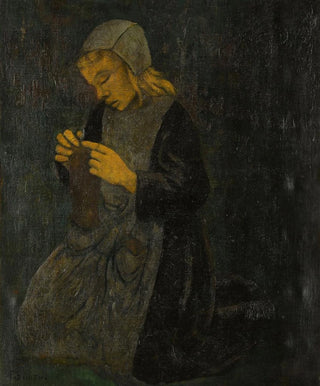Art print | Young Breton girl knitting - Paul Sérusier


View from behind

Frame (optional)
Art print Jeune bretonne tricotant - Paul Sérusier – Captivating Introduction
In the vast landscape of modern art, certain works stand out for their ability to capture the essence of a culture and a specific moment. "Jeune bretonne tricotant" by Paul Sérusier is one of those iconic pieces that evoke not only the beauty of everyday life but also the richness of Breton traditions. Created in 1888, this piece transports us into a universe where the simplicity of daily gestures blends with a vibrant color palette, offering a deep immersion into the soul of Brittany. Sérusier, as a member of the Nabi movement, seeks to express a personal vision of the world, and this canvas is a perfect reflection of that.
Style and uniqueness of the work
Paul Sérusier's style is characterized by a bold and innovative approach to color and composition. In "Jeune bretonne tricotant," he uses strong hues and simplified shapes to evoke the presence of the young woman at the center of the canvas. The contrast between warm and cool colors creates a captivating visual dynamic, inviting the viewer to focus on the details. The way light plays on the textures of the clothing and the Breton woman's face demonstrates undeniable technical mastery. Each brushstroke seems charged with emotion, paying homage to rural life and the beauty of everyday gestures. This work does not merely depict a scene; it transcends it, offering a poetic and almost spiritual vision of Breton life.
The artist and his influence
Paul Sérusier, a central figure of the Nabi movement, managed to marry Impressionism with a more symbolist vision of art. His artistic journey was marked by decisive encounters, notably with artists such as Émile Bernard and Paul Gauguin, who encouraged him to explore new paths. Sérusier was one of the first to incorporate elements of popular culture into his work, seeking to express deep emotions through simple motifs. "Jeune bretonne tricotant" perfectly illustrates this approach, where the artist does not merely depict a scene but seeks to extract its essence and transmit it.

Matte finish

View from behind

Frame (optional)
Art print Jeune bretonne tricotant - Paul Sérusier – Captivating Introduction
In the vast landscape of modern art, certain works stand out for their ability to capture the essence of a culture and a specific moment. "Jeune bretonne tricotant" by Paul Sérusier is one of those iconic pieces that evoke not only the beauty of everyday life but also the richness of Breton traditions. Created in 1888, this piece transports us into a universe where the simplicity of daily gestures blends with a vibrant color palette, offering a deep immersion into the soul of Brittany. Sérusier, as a member of the Nabi movement, seeks to express a personal vision of the world, and this canvas is a perfect reflection of that.
Style and uniqueness of the work
Paul Sérusier's style is characterized by a bold and innovative approach to color and composition. In "Jeune bretonne tricotant," he uses strong hues and simplified shapes to evoke the presence of the young woman at the center of the canvas. The contrast between warm and cool colors creates a captivating visual dynamic, inviting the viewer to focus on the details. The way light plays on the textures of the clothing and the Breton woman's face demonstrates undeniable technical mastery. Each brushstroke seems charged with emotion, paying homage to rural life and the beauty of everyday gestures. This work does not merely depict a scene; it transcends it, offering a poetic and almost spiritual vision of Breton life.
The artist and his influence
Paul Sérusier, a central figure of the Nabi movement, managed to marry Impressionism with a more symbolist vision of art. His artistic journey was marked by decisive encounters, notably with artists such as Émile Bernard and Paul Gauguin, who encouraged him to explore new paths. Sérusier was one of the first to incorporate elements of popular culture into his work, seeking to express deep emotions through simple motifs. "Jeune bretonne tricotant" perfectly illustrates this approach, where the artist does not merely depict a scene but seeks to extract its essence and transmit it.






